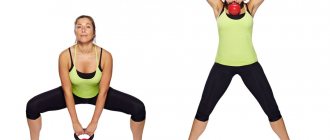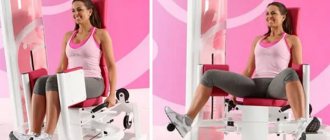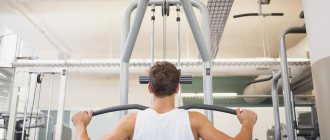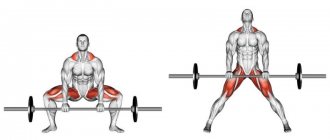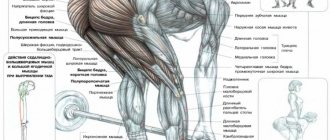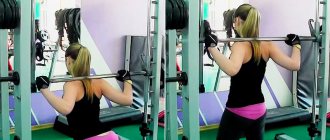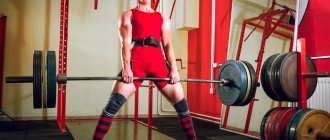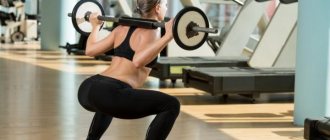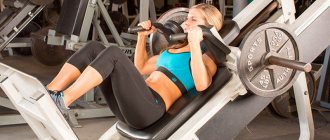Sumo squats are an effective exercise for training the buttocks and adductor surface of the thigh; it will be relevant not only for the fair half of humanity, but also for men, this type of squats is also useful, since with a certain placement of the feet, the load also falls on the quadriceps. The exercise does not involve additional muscles that stabilize the body position, which can be considered an advantage. Squats are performed not only with a barbell, but also with a dumbbell and in a Smith machine. So, what are sumo squats and whether this type of load should be included in the training process, we will find out right now!
Benefits and Disadvantages of Sumo Squats
This exercise is suitable for both men and girls due to its active effect on the muscles of the lower body. When performing sumo squats, those muscles are used that are not used in the classical squat technique. It is also worth noting the following advantages of sumo squats:
- Complex work of the muscles of the legs and buttocks.
- Effective work of the adductor muscles, which is a very relevant activity in women's training.
- Improves hip flexibility and mobility.
- Effectively improves blood circulation in the legs and pelvic organs.
- Ability to work with various weights and sports equipment (barbell, dumbbell, kettlebell, bag and other equipment).
- Sumo squats are suitable for a home exercise routine.
- By reducing the inclination with a dumbbell, the load on the lower back is reduced.
Of course, there are also disadvantages.
- For example, the technique of performing sumo squats is somewhat more complicated than the classic version. In this case, you need to squat widely and carefully ensure that your knees do not bend inward. To do this, you need to use a light weight, at least at first.
- It is also worth noting that sumo squats place a significant load on the knee and hip joints, which, by the way, are in an unusual position throughout the entire range of motion.
Contraindications to squats
Such exercises are contraindicated for problems with the lower back, spine and knees. You also don’t need to do it if you have weak core muscles. In any case, the load on such areas should increase over time.
There are a number of common mistakes that some people make with plie squats. This includes straightening the legs at the top, strongly arching the back, looking down or looking down, knees going beyond the toes, and the use of weights that are too heavy. To prevent such mistakes from happening and make the exercise safer and more correct, you need to follow some recommendations from experts:
- When rising from a squat position, you should try not to straighten your legs completely, as this will put a lot of stress on the knee and reduce overall tension in the muscles.
- When performing squats, it is very important to pay special attention to the correct technique. It is better to take less weight, but from a technical point of view, do everything correctly.
- The knee joint should move in the direction of the toe of the foot, without being limited by its general plane. It will be easy to avoid such a mistake - move your pelvis back, as the technique of this exercise suggests.
- When doing squats, look straight or slightly up. This will help control the load in your hands.
- If the general position of the back is incorrect, there is a risk of injury to the lower area. To prevent this, you need to constantly keep your spine straight.
- The vertical position of the spine is typical when squatting. The correct exercise technique involves moving your pelvis as far back as possible, as if you were trying to sit down on an imaginary chair, while tilting your body slightly forward.
Also during squats you need:
- The amplitude range is considered an individual parameter for everyone. Squats can be deep, as well as with a reduced range of motion. The main tactics in this case are given to the training goal. If you want to work the muscles of the buttocks, then you need to squat low and deep. If you move more than parallel, then it is the quadriceps muscles that will be worked.
- Also, the muscles that will take part in the exercise directly depend on the rotation of the feet and knees. The external orientation pumps up the adductor muscles more, and when the toes are brought together, the load goes to the quadriceps, which is why the exercise loses its effectiveness. You need to turn your toes at an angle of 45 degrees. But with the correct squatting technique, this can be noticeably corrected.
- As with other squats, the sumo technique greatly affects the lumbar region of the back, which is why if you perform the exercise, you need to further strengthen this area using hyperextension.
- There is no need to use too heavy loads. You can understand that you have overdone it this way: if during the normal course of the exercise you make an involuntary jerk with your pelvis, then the weight is too heavy for you.
- At the lowest point, it is best to stop for 2-3 seconds, and then rise sharply and quickly to the starting position.
- To prevent knee injuries from occurring, you need to carefully ensure that your knees are parallel to your feet.
- The weight during squats should be transferred to the heels. This will help to optimally stimulate the gluteal muscles, it will also be rational in terms of biomechanics.
- At this time, you need to keep your back in a level position, arching at the lower back.
- Before performing the exercise, you need to do a little warm-up and stretching. It is important to pay more attention to stretching the inner thigh area.
- Watch your breathing, and perform the main effort during exhalation.
What muscles work in sumo squats?
The exercise affects the following muscles:
- Adductor muscles of the thigh.
- Quadriceps femoris muscles.
- Large gluteal muscles.
Indirectly and to a lesser extent, the hamstrings are involved, as well as the spinal stabilizer muscles, back muscles, abdominal muscles and calf muscles.
Important points
In conclusion, it is worth adding a few recommendations to make wide squats as effective and safe as possible:
- During the movement, the body weight is on the heels. When you push from the bottom of a squat, you do so with your heels on the floor.
- Watch the position of your legs. Your shins are in a plane parallel to your feet. Otherwise, knee injury is very likely.
- Keep your back straight, arching at the lower back. Try not to bend your body forward more than 45 degrees.
- Before performing the exercise, be sure to warm up and do some stretching. Pay special attention to stretching your inner thighs.
- Sumo squats with a barbell or dumbbells use less weight than classic squats. For girls, it is recommended to start without weight or with an empty bar.
- The gaze is directed forward while performing the movement. There is no need to lower your head.
Following these simple rules will help you perform the exercise correctly.
And the ideal technique, in turn, will allow you to thoroughly work out the inner thighs, strengthen the muscles of the legs and buttocks. By performing this exercise with a barbell or one or two dumbbells, you will achieve maximum results. Source
Sumo squat technique with a barbell
The barbell sumo squat is similar to the dumbbell technique.
- The athlete must remove the barbell from the rack or frame, spread his legs wide and turn his toes 45 degrees to the sides.
- The bar should rest on the trapezius muscles, as with classic squats.
- During the downward movement, inhale, and during the return movement, exhale.
Please note that your knees should be pointing in the same direction as your feet. The pelvis must be moved back.
Execution options
Exercises can be performed with dumbbells, kettlebells, barbells . If you do squats with sumo dumbbells, you can hold them in your arms down or at chest level.
Sumo squats with a kettlebell are done in a similar way, but it is better to keep it at the bottom. The barbell can be placed on the shoulders or also lowered down.
You can do exercises without weights at all. This option is suitable for beginners who are just mastering the technique of the exercise or cannot perform it with weights. It is difficult for an untrained person to maintain balance during a wide squat, especially with a weight.
Features and technique of sumo squats with a dumbbell
- Take your starting position, standing straight and maintaining a natural arch in your lower back.
- Your legs should be placed wide apart, your feet should be turned to the sides. The width of the legs is determined individually, since each athlete has different flexibility. In any case, they should be positioned wider than shoulder width.
- It is enough to turn your feet at an angle of 45 degrees.
- At the lowest point of the range of motion, the hips should be parallel to the floor.
- The dumbbells need to be lowered with outstretched arms in front of the body, or you can work with one dumbbell, holding it by the weighting disk, which is much more convenient and minimizes the tilt of the body.
Who is the exercise suitable for?
Sumo squats are considered more of a female training option. But due to the fact that the quadriceps muscles are also occupied here, the exercise is also suitable for athletes who have some physiological problems that do not allow them to perform heavier elements. For example, training would be suitable:
- athletes with problematic joints, as wide stance of the legs reduces the load on the knees;
- for athletes with insufficient ankle mobility - in the classic version, the heels come off the floor and stiffness of the joints occurs - sumo squats solve this problem.
The training is also suitable for athletes who want to use maximum weights, since the technique ideally allows this and provides a powerful incentive to develop strength indicators.
Recommendations
When performing this type of squats, do not go for too much weight . And it’s better to practice the technique with an empty bar or without any weighting. Another very important point is the depth of the squat. With an amplitude in which the thigh falls below parallel with the floor, the gluteal muscles are more loaded, and the load on the knee joints increases.
Sumo squats for girls
Women should include this exercise in their training as the main possible squat. Of course, you don’t need to ignore classic squats, but sumo squats are considered a priority. You can add glute bridges, wide lunges or Bulgarian lunges to your training complex.
Sumo squats for men
Sumo is not as relevant for men, but it can still be used in leg training. Typically, sumo squats are included as the second or third exercise after performing the main load on the quadriceps.
Here's an example of a leg workout using sumo squats:
- Barbell squats with a classic foot position or leg press with a wide foot position.
- Sumo squats with barbell.
- Lunges with dumbbells (walking).
- Leg extension in the simulator.
- Leg bending in the simulator.
- Exercises for the lower leg muscles.
What is a plie squat
The plie squat is a movement in which you stand with your feet approximately twice shoulder-width apart, point your toes and knees out to the sides, and lower yourself toward the floor in that position.
The Lifehacker Telegram channel contains only the best texts about technology, relationships, sports, cinema and much more. Subscribe!
Our Pinterest contains only the best texts about relationships, sports, cinema, health and much more. Subscribe!
The name of the exercise comes from the ballet element plie of the same name, in which the knees and toes are also oriented outward.
Unlike choreography, in strength training there is no clear definition for the plie squat. Some believe that this is another name for sumo squats, others believe that they are two different exercises.
It's difficult to say who is right here. But since in powerlifting a squat with wide feet and pointed toes is called “sumo,” and the term “plie” is more often used for a super-evolution movement without weight, we will assume that these are different exercises.
